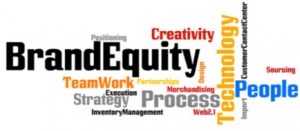Circle Research described brand equity as “a perception held in an individual’s mind and created by the sum of their experience.” In B2B, having a strong brand makes your product or service a total must-have.
Creating a Strong Brand
A strong brand is typified with honesty, allure, prominence, emotional and rational enticement, being established on a distinct and moored concept, and having the impression that it is always better than the other.
 It also becomes the benchmark of differentiation and is created and developed by thoroughly understanding what the consumers want and how they see the brand. More so consumers prefer a strong brand since it gives them a safe choice in a market where there is always something new.
It also becomes the benchmark of differentiation and is created and developed by thoroughly understanding what the consumers want and how they see the brand. More so consumers prefer a strong brand since it gives them a safe choice in a market where there is always something new.
In positioning your brand, you should delve into its essence, establish what do you want it to represent, and ascertain the position of your competitor. All of these will lead to your initial brand statement. The next step is to know the perceptions of your current consumers, target consumers, and opinion formers using various approaches and methodologies. Through these, you will be able to develop your brand into something that is relevant and apt, thereby positioning it a lot better.
Lastly, by employing a quantitative survey and utilizing statistical techniques, you can now determine the ultimate brand positioning strategy to be followed.
Brand Awareness
The thing with small-scale enterprises and startup companies is that they invest most of their time strategizing how they can improve and increase their sales by creating marketing campaigns and developing their pitches. Probably the most important factor that will make or break their pitch, but is usually disregarded, is brand awareness. Going back to the phases of a customer’s buying cycle, brand awareness plays a significant role in helping customers what to purchase from an array of choices. For instance, a consumer is looking for a beauty product. Before he/she relies on Google for potential suppliers, the consumer will search first the product line of companies that he/she is already aware of. Most of the times, the products of these companies serve as the consumers’ benchmark in looking for other products available in the market. With brand awareness, your product becomes a part of the customers’ list. In B2B, brand awareness shortens the time needed for completing the consumer’s buying cycle.
There are two techniques that B2B companies can use in building brand awareness: content marketing and public relations. For startup companies, these two approaches are more efficient and cheaper compared to traditional advertising. In content marketing, a business aims to generate responses (e.g. inquiries regarding the product or service) through informative and interesting content that the company created and disseminated. On the other hand, public relations is a marketing strategy wherein the business pitches stories related to the company’s brand, product, service, or the company itself, to the press.
But What is Brand Equity?
Brand equity is the brand’s worth or value in the market. It manifests consumers’ valuation of the brand and involves brand recognition, customer loyalty, and brand awareness. It also pertains to the brand’s value that invokes affirmative mental and emotional associations.
Components of Brand Equity
If there is brand loyalty, there is brand equity and an increase in market share. Generally, brand equity is composed of five different phases of brand experience: brand awareness, brand recognition, brand trial, brand preference, and brand loyalty.
Brand awareness pertains to consumers’ awareness of the brand.
Brand recognition refers to consumers’ understanding of the brand and its offerings.
Brand trial describes the process by which the consumers try and assess the brand.
Brand preference relates to consumers’ liking of the brand, thereby turning into repeat customers.
In brand loyalty, the customer developed an emotional attachment to the brand.
Measuring Brand Equity
Since brand equity can’t be quantified that easily, marketers and researchers use tools and metrics in order to evaluate it. For instance, one can gauge the strength of a brand based on its differentiation, perceived quality and value, popularity, market share and market price, organizational affiliations, personality, customer loyalty, and extent of brand awareness.
Brand equity can also be gauged depending on its level: firm (brand equity is evaluated as a financial asset and appraised as an intangible asset), product (comparison of the brand against a well-known or a not so popular brand), or consumer level (those having high brand awareness and unique associations are regarded as brands with high equity).
Benefits of Having Strong Brand Equity
A positive and strong brand equity can help and support a business in a lot of ways.
There will be an increase in margins. A strong and positive brand equity lets businesses charge a premium for their products or services since customers are willing to pay for it.
There will be customer loyalty. Not only that customers will pay for your product or service, but they will be retained and repeat their purchase.
There will be new opportunities. Through a positive and strong brand equity, companies can further their growth and expansion goals. They can introduce new products and penetrate new markets.
There is a competitive advantage. Consumers will buy any products as long as the company’s logo is in there.
